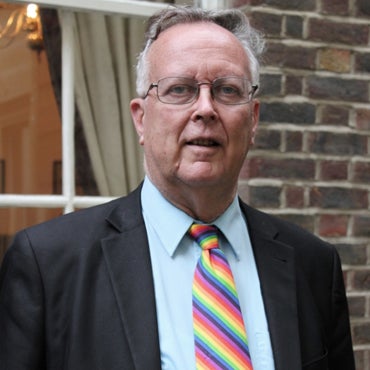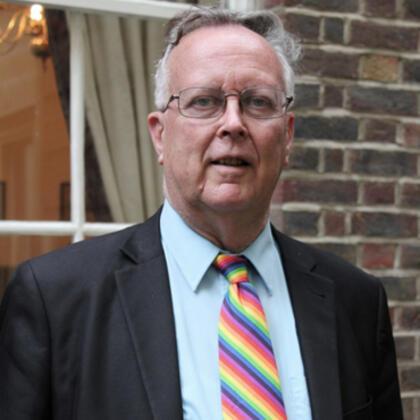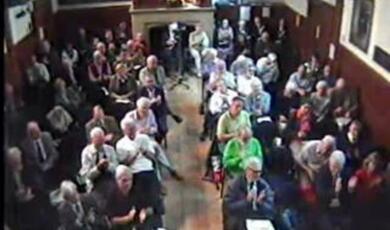Thomas Hirst (1887): Ah, why was Newton ever born?
Share
- Details
- Transcript
- Audio
- Downloads
- Extra Reading
Thomas Hirst (1830-1892) recounts the period of mathematical history through which he lived.
Download Transcript
Thomas Hirst (1887): Ah, why was Newton ever born?
Professor Robin Wilson
Ladies and Gentlemen,
I feel greatly privileged to lecture in this beautiful building, as many of my finest scientific experiences have taken place in this very room. Thirty-five years ago, when I was a humble schoolteacher in Hampshire, I used to visit the Royal Institution with my good friend John Tyndall to attend the discourses of the great Michael Faraday, as I recorded in my diary:
Friday evening I attended Faradays lecture Electricity of induction, static and dynamic effects. The lecture room was filled with a very brilliant audience, and the lecture itself pleased me much. Perhaps the lecturers manner, person and celebrity attracted me much. There was about him such a total absence of mannerism and pretension, such geniality and gentleness.
After Faraday's death, Tyndall continued here as Professor of Natural Philosphy, becoming one of the most celebrated popularisers of Victorian science. His research ranged from magnetism and heat radiation to the movement of glaciers, and he was the first to explain why the sky is blue. A well-known picture shows him in this theatre, giving one of his discourses.
The thirty-five years that I have been attending the Royal Institution have witnessed a dramatic expansion in mathematical activity in this country, as I will shortly relate. This contrasts markedly with the wretched situation in the 18th century, when the stranglehold of Newtonianism held back British mathematics for a hundred years or more.
As soon as Sir Isaac Newton became President of the Royal Society in 1703, following the death of his rival, Robert Hooke, power went to his head. First he apparently ordered that all portraits of Hooke should be destroyed certainly none has survived. Next, he successfully influenced all scientific appointments, such as the choice of professors in the ancient universities and of the Astronomer Royal, with the result that Newtonian philosophy became deeply embedded everywhere. Indeed, irritated by the priority claims of Leibniz on the Continent over the invention of the calculus, he set up a Royal Society Commission to investigate the matter. For this purpose he chose the members of the Commission himself and wrote most of the evidence for them, so it was inevitable that the Commission came down in favour of Newtons priority completely ignoring the fact that Leibniz was the first to publish his results. In fact, so convenient was Leibniz's choice of notation, such as the integral sign, that we still use it in preference to Newtons notation.
With Newtons supporters in every position of authority, it is not surprising that the British academic community largely ignored the great mathematical advances on the Continent. Following Leibniz, the Bernoulli brothers, Jakob and Johann, mastered and developed the new Continental calculus, introducing the word integral and developing the idea of polar coordinates. Johann Bernoullis employer, the Marquis de lHôpital, wrote the first printed calculus text, incorporating many of Bernoullis own results, such as the so-called lHôpitals rule for calculating limits. But lHôpital was a brilliant writer, and his calculus book exerted great influence, running into many editions.
The next important Continental figure was Leonhard Euler, probably the most prolific mathematician of all time. He worked in all areas of mathematics and the physical sciences, from the purity of number theory via mechanics and differential equations, to magnetism and astronomy. Euler was the first to use the idea of a function, and introduced the notation f(x) for a function of x. Indeed, he also introduced other notations that are still in common use: i for the square root of minus 1, e for the exponential number, and a capital Greek sigma for summation. The familiar symbol p, for the ratio of the circumference of a circle to its diameter, was not invented by him the credit goes to an Englishman, William Jones in 1706 although Euler did help to standardise it. Incidentally, also in 1706, John Machin, the Gresham professor of astronomy, introduced his celebrated formula for p involving inverse tangents, from which he calculated p to one hundred decimal places. Recently, in 1873, William Shanks used Machins formula to compute p to 707 decimal places.
Compared with such intellectual giants as Leibniz, the Bernoullis and Euler, and their illustrious successors Lagrange, Laplace and Gauss (whom I had the privilege of meeting in my student days) the British mathematicians of the time seem but nothing. Names such as Brook Taylor and Colin Maclaurin pale into insignificance, even though by British standards they were substantial figures.
So what were their main achievements? Brook Taylor is now mainly remembered for the Taylor series, or Taylor expansion, in which a given function is written as a series of powers of x. But Taylor was not the first to obtain such series and nor was the Scottish mathematician Colin Maclaurin so the terms Taylor expansion and Maclaurin expansion seem something of a misnomer. However, Brook Taylor did contribute some useful work on geometry specifically on linear perspective. A painting shows him with the manuscript of his book. It was a thorough treatise on the geometrical ideas underlying perspective drawing, starting from the simplest notions of projection, and it seems to have been Taylor who introduced the term vanishing point. Taylors book was certainly influential a later treatise on perspective by Thomas Malton includes the inscription To the memory of Dr. Brook Taylor in Gratitude for his sublime principles on Perspective.
In contrast, Newtonian calculus was being soundly criticised. In 1734 George Berkeley, later Bishop of Cloyne in Ireland, wrote a treatise entitled The Analyst, or a discourse addressed to an infidel mathematician probably Edmond Halley wherein it is examined whether the Object, Principles and inferences of the modern analysis are more distinctly conceived, or more evidently deduced, than Religious Mysteries and Points of Faith.
Berkeley was criticising as shaky the foundations of Newtons calculus, and consequently all of the physics and gravitation theory that was based on it. In particular, Newton had mentioned infinitely small quantities, a term whose meaning is unclear; and in using these quantities. He first supposed them to be unequal to zero, and later they equal zero.
He used these fluxions like the scaffold of a building, as things to be laid aside or got rid of. What are these fluxions? The velocities of evanescent increments? And what are these same evanescent increments? They are neither finite quantities, nor quantites infinitely small, not yet nothing. May we not call them the Ghosts of departed quantities?
In spite of Berkeleys flowery language, his criticisms were well informed, and hurt the Newtonians to the quick. They rushed to the defence of Newtons calculus, and Colin Maclaurin tried to put Newtons work on a rigorous footing. His book was much admired but little read. The problems were not fully overcome until the 1820s, when the French mathematician Cauchy introduced the concept of a limit.
But if Newtons calculus was under threat, his gravitation (as presented in the Principia) was achieving notable successes. Newton had predicted that the earths motion leads to a flattening of the earth at the poles, so that the earth is onion-shaped. Descartes rival vortex theory, which Newton had demolished in the Principia, had predicted a lengthening at the poles, so that the earth is lemon-shaped. The difference mattered in particular, to those navigating at sea and national pride was at stake. Eventually, geodetic missions were sent to measure a pendulums time of swing in Peru on the equator and Lapland in the far north, and thereby to determine who was correct. Newton was proved to be right.
Another success was Halleys comet. On the basis of Newtons Principia results, Halley predicted that a comet that he had seen in 1680 was the same one that had appeared in 1533 and 1607, and would reappear around Christmas 1658. When it did so, sixteen years after Halleys death, Newtonian gravitation received a great boost and the comet was named after Halley. It is small wonder that Alexander Pope had been moved to say about the Principia:
Nature and Natures Laws lay hid in night;
God said, Let Newton be!, and all was Light.
Meanwhile, Newtons ideas increasingly pervaded the teaching in the ancient universities of Oxford and Cambridge. As far back as 1692, only five years after the appearance of the Principia, David Gregorys inaugural lecture as Savilian Professor of Astronomy in Oxford emphasised Newtons contributions to celestial physics. And a book by James Stirling presents Newtonian lines of the third order, the first proficient exposition of Newtons work on cubic curves.
Lectures on Newtonian science were given in the Old Ashmolean Museum, the earliest building in the country for the teaching of experimental science. They were presented in a similar form for many years in particular, by James Bradley, the Savilian Professor of Astronomy. Bradley was the living embodiment of the Newtonian tradition, having known both Newton and Halley personally and being Halleys acknowledged successor both in Oxford and as Astronomer Royal at Greenwich. Most of the men who attended the lectures at the Old Ashmolean seem to have been Bachelors of Arts preparing for their Master of Arts degrees and for holy orders.
By the time of his death in 1762, Bradley had revolutionised astronomical observation. His published observations set a new standard for accuracy and procedure which subsequent astronomers were obliged to follow. In particular, his immediate successor as Savilian professor, Thomas Hornsby, masterminded the construction of the Radcliffe Observatory in Oxford a beautiful building, based on the Tower of the Winds in Athens, which soon became the best-equipped astronomical observatory in the world. It was the first academic establishment to combine teaching and research in astronomy, using instruments of the highest quality, such as an enormous quadrant by John Bird. Unfortunately, it was all too good to last. By the time Hornsby died, its instruments had become antiquated, compared with those elsewhere in Europe.
Teaching, too, had been in decline for many years, and the economist Adam Smith was moved to write:
The greater part of the publick professors have, for these many years, given up altogether even the pretence of teaching…
while James Harris, later First Earl of Malmesbury, recalled:
The two years of my life I look back to as most unprofitably spent were those I passed at Merton. My tutor, an excellent and worthy man, according to the practice of all tutors at that moment, gave himself no concern about his pupils. I never saw him but during a fortnight, when I took it into my head to be taught trigonometry,
And the 15-year-old Jeremy Bentham reported to his father:
Mr Bliss seems to be a very good sort of a Man, but I doubt is not very well qualified for his Office, in the practical Way I mean, for he is obligd to make excuses for almost every Experiment, they not succeeding according to expectation.
Examinations, such as this one, were no better:
What is the Hebrew for the place of a skull? I replied Golgotha. Who founded University College? I stated (though by the way, the point is sometimes doubted) that King Alfred founded it. Very well, Sir, said the Examiner, you are competent for your degree.
In Cambridge some years earlier, two interesting events had happened. William Whiston, Newtons successor as Lucasian professor, had lost his appointment on account of his fervent religious views. In 1714 he co-authored a pamphlet on the problem of finding longitude at sea, one of many such tracts on the subject. Whistons successor, Nicholas Saunderson, delivered a course of lectures on experimental philosophy, which greatly inspired the young John Harrison, who made this copy headed Mr Saundersons Mechanicks. These mentions of the longitude problem and of John Harrison bring us to one of the most interesting stories of this discourse the determination of longitude at sea.
Everyone knows the lines of latitude and longitude on the globe theyve been used since before the birth of Christ, and Ptolemy recorded the latitude and longitude of some 8000 places around 200 AD. The horizontal lines of latitude are easy to measure while at sea one simply measures the angle between the horizon and the sun or certain stars, or it can be calculated from the length of the day. But unlike latitude, where there is a fixed central line (the equator), the vertical lines of longitude are measured from an arbitrary line very recently chosen to be the meridian at Greenwich. To find ones longitude at sea seems simple enough: one needs to compare ones local time with the time at home each hour of difference corresponds to 15 degrees of longitude.
As the anonymous Ballad of Gresham College observed:
The College will the whole world measure;
Which most impossible conclude,
And Navigation make a pleasure
By finding out the Longitude.
Every Tar shall then with ease
Sayle any ship to the Antipodes.
The problem was that the clocks of the early 18th century were unreliable at sea. With the rolling of the ship pendulum clocks cannot be used, while those containing oil as a lubricant are unreliable in very hot or very cold climates.
This was not just a theoretical problem many lives had been lost at sea through the inaccurate determination of longitude. Indeed, in 1707, sixteen hundred lives were lost in a single night, when Sir Cloudisley Shovells ship The Association (and three others) struck the rocks around the Isles of Scilly. The British Parliament, stung to action, set up the Board of Longitude and offered the enormous prize of £20,000 for a successful and reliable solution.
The long saga of John Harrisons 40-year attempt to construct a suitable chronometer is well known. His first marine timekeeper, known as H1, stands two feet high, took five years to make, and was fairly accurate. Eventually he produced the pocket-watch size H4, which was tried successfully on a number of transatlantic voyages. James Cook took a version of it on his voyages to the southern seas, and pronounced himself pleased. But the Longitude Board was under the influence of Nevil Maskelyne, the Astronomer Royal, who sought an alternative lunar method, and it was only after the direct intervention of King George III, who was interested in science, that the prize went where it deserved. Incidentally, Hogarths engraving from The Rakes Progress lampoons a mad mathematician at the back scribbling a method actually, William Whistons method for determining longitude.
By 1800 Oxford and Cambridge science had gone into decline. The professors lectured rarely, and degree examinations became increasingly perfunctory. According to the Westminster Gazette the universities had long since ceased to exist except for electoral purposes, while another source claimed that the idle students spent their time in fornication, wine and betting. Heres an Oxford student of the time an Oxford macaroni, so-called because they belonged to a club where macaroni was eaten and the Cambridge macaroni was little better.
However, change did come eventually. Examinations, formerly by disputation, were reformed in the 1820s and included written papers. Here are four varied questions from the earliest Oxford written papers of 1828 and 1829:
1. What decimal of a week is 1 hour 7 minutes and 14 seconds?
2. Apply Maclaurins Theorem to find the tangent in terms of the arc.
3. A box in the form of a parallelepiped is filled with spherical balls. What proportion of the space is unoccupied?
4. The altitude of the sun was observed to be half of his declination at six oclock. Prove that twice the sine of the latitude of the place = the secant of the suns latitude.
One of Oxfords reformers at this time was the Savilian professor of geometry from 1827 to 1860, the Reverend Baden Powell, who wrote texts in geometry and calculus, made significant discoveries in optics, and was a populariser of mathematics and science. Powell gave a public lecture on The present state and future prospects of mathematics at the University of Oxford, and was an enthusiastic supporter of the British Association for the Advancement of Science, founded in 1831.
In 1847 Powell gave a two-hour popular lecture on Falling stars at the Oxford British Association meeting, where the main speaker was John Couch Adams, who had recently discovered the planet Neptune. Adamss lecture was attended by the independent discoverer Le Verrier; the French press gave all the credit to Le Verrier rather than the British co-discoverer who is shown looking in the wrong direction.
An interesting educational issue started to feature around this time, encouraged by Baden Powell the attempts to reform the teaching of geometry in schools. Such teaching often consisted of rote learning of the material with little understanding, and one examiner complained that a student had reproduced a proof from Euclid perfectly, except that in his diagrams he drew all the triangles as circles.
I myself had taught practical geometry, such as surveying, while a schoolmaster in Hampshire in the 1850s, and in London in the 1860s, and when a society was set up a few years later, the Association for the Improvement of Geometrical Teaching, I was elected as its first president, a position that I held for almost eight years.
One of our opponents was Charles Dodgson, or Lewis Carroll, who in addition to writing the Alice books, Alices adventures in Wonderland and Through the looking glass, was a mathematician in Oxford. Dodgson was a great enthusiast for Euclid, and wrote a short drama called Euclid and his modern rivals in which a number of other geometry books were compared, unfavourably in every case, with Euclids Elements.
There is even a Scottish student song bemoaning the singers lack of ability to do geometry:
Devoid of mathematic brain,
I puzzle over x and y;
Dull propositions are a pain,
I never yet digested p.
Twere hard to know the reason why,
But Maths have always been my thorn,
And thus I never cease to cry
Ah, why was Euclid ever born?
But we are running ahead of ourselves. In Cambridge in 1812 three Cambridge students surveyed the mathematical scene around them and were dismayed. The stranglehold of Newtons methods still held sway, and these students, John Herschel, Charles Babbage and George Peacock, formed a society, the Analytical Society, to replace them by the much more successful Continental approach.
John Herschel was the son of the German astronomer William Herschel. Charles Babbage, who was elected to the Lucasian Chair in mathematics at Cambridge (Newtons former Chair), was a designer of calculating machines of great sophistication. His difference engine, if built, would have calculated with enormous power. A later machine of his, the analytical engine, was also never built, but was written about extensively by Ada, Countess of Lovelace and daughter of Lord Byron.
Ada Lovelace was not the only woman mathematician around at the time. Mary Somerville, after whom an Oxford college has recently been named, was a noted scientific writer, the translator of the works of Laplace, and a foremost advocate for womens education. And Florence Nightingale, the Lady with the Lamp, used statistical methods to analyse the mortality data that she collected during the Crimean War.
The Analytical Society in Cambridge led to a blossoming of mathematics in that town, particularly in applied mathematics. A celebrated theorem, known as Greens theorem, is named after George Green, a miller from Nottingham, who studied at Cambridge University after spending twenty-five years working in his mill. He passed the mantle on to George Gabriel Stokes, whose most well-known result, Stokes theorem, made its first appearance in a Cambridge examination paper. But the most distinguished of the Cambridge applied mathematicians was James Clerk Maxwell, who was elected a Fellow of the Royal Society on the same day that I was. His greatest triumph was the so-called Maxwells equations the mathematical equations that explain the experimental work of Faraday carried out in this very building.
With Faraday we seem to have come full circle, but before concluding Id like to mention one recent development in this country that supports my conviction that the tide has at last turned for mathematics and that is the founding, just over twenty years ago, of the London Mathematical Society.
It was founded in 1865 with Augustus De Morgan as its first President, and myself as Treasurer. De Morgan, remembered for De Morgans laws in set theory, was professor of mathematics at University College in London for some forty years, and was a well-known populariser of mathematics. The meetings were initially held at University College, before moving to Albemarle Street, just next door to where we are today.
The next two London Mathematical Society presidents were this countrys greatest algebraists both still alive. Arthur Cayley, the inventor of the algebra of matrices and Sadleirian professor of mathematics at Cambridge, lectured to the Society on more than seventy occasions. Cayley has written much on the theory of invariants, often with James Joseph Sylvester, one of mathematics great eccentrics, who has applied his genius to several areas, and who has recently been elected as Savilian professor of geometry at Oxford. In his inaugural lecture he even included a sonnet an ode to a missing term in an algebraic expression:
To a missing member of a family group of terms in an algebraical formula
Lone and discarded one! divorced by fate,
From thy wished-for fellows -- whither art flown?
Where lingerest thou in thy bereaved estate,
Like some lost star, or buried meteor stone?
Thou mindst me much of that presumptuous one
Who loth, aught less than greatest, to be great,
From Heavens immensity fell headlong down
To live forlorn, self-centred, desolate:
Or who, new Heraklid, hard exile bore,
Now buoyed by hope, now stretched on rack of fear,
Till throned Astræa, wafting to his ear
Works of dim portent through the Atlantic roar,
Bade him the sanctuary of the Muse revere
And strew with flame the dust of Isis shore.
It was while I myself held the Presidency of the London Mathematical Society that I was appointed the first Director of Studies at the Royal Naval College in Greenwich. I have recently retired from this position to devote more time to my studies, and in particular, to prepare this account of the past 150 years. It has indeed been a privilege to join with my predecessors Henry Briggs and Edmond Halley in this fine lecture room to survey A Thousand Years of British Mathematics.
© Robin Wilson
This event was on Thu, 21 Nov 2002
Support Gresham
Gresham College has offered an outstanding education to the public free of charge for over 400 years. Today, Gresham plays an important role in fostering a love of learning and a greater understanding of ourselves and the world around us. Your donation will help to widen our reach and to broaden our audience, allowing more people to benefit from a high-quality education from some of the brightest minds.


 Login
Login







